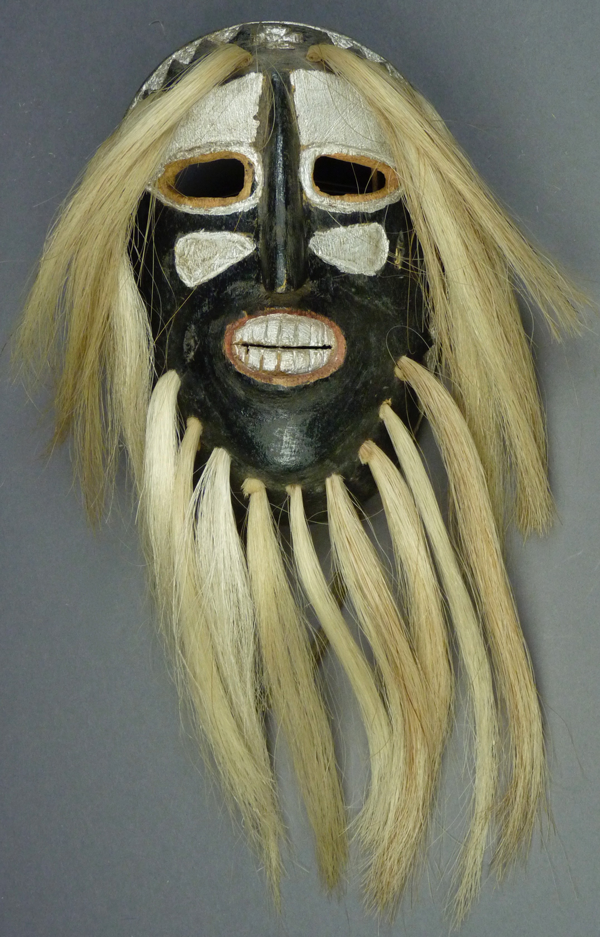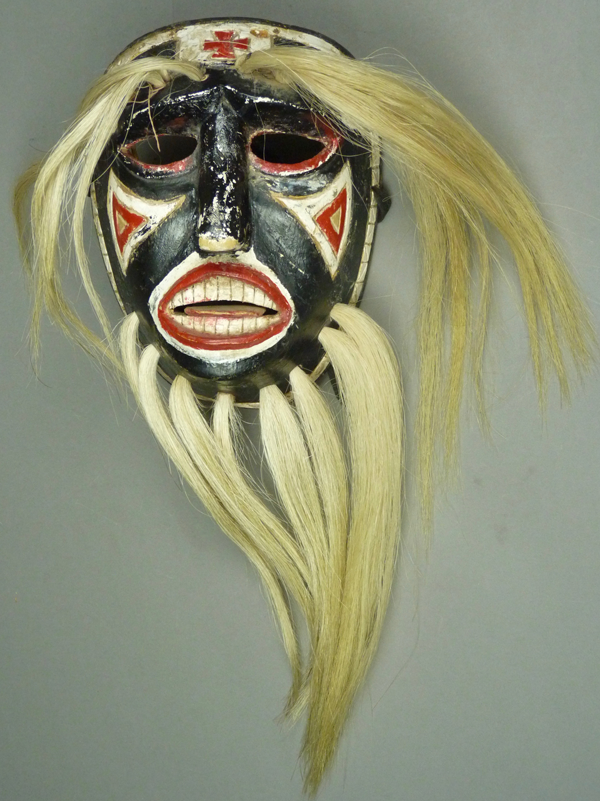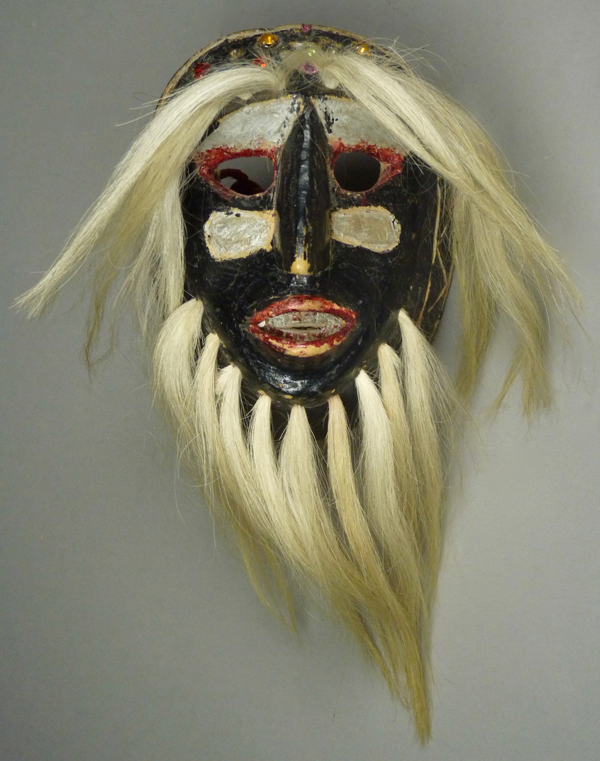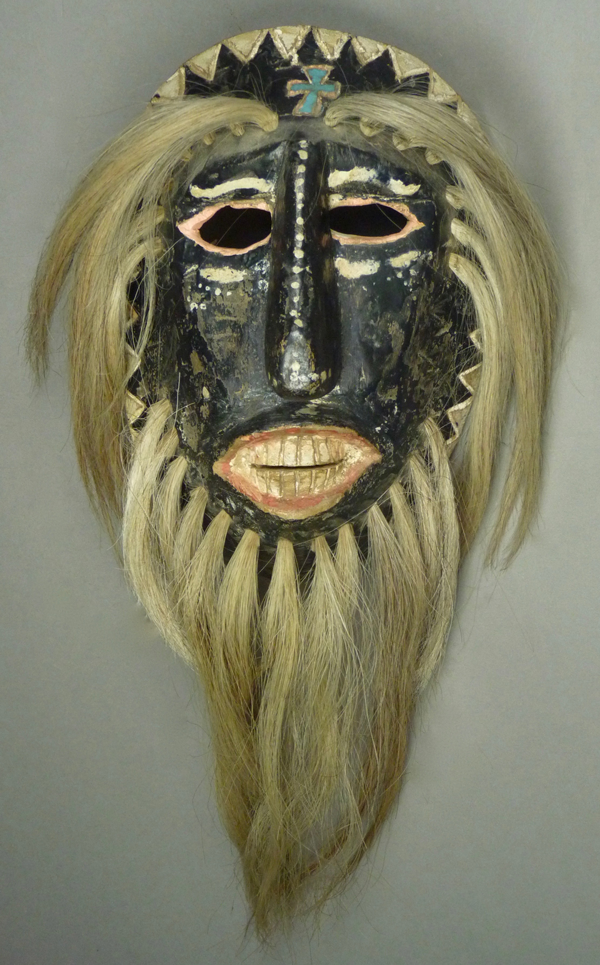Today we will examine four more beautiful old masks that were carved by Francisco “Pancho” Parra. I photographed the first three in the collection of Jerry Collings in 2011, and he kindly gave me permission to publish them as I wished. It is my understanding that those three may have been later traded to the Gallery West in Tucson Arizona. The first of these was collected from Eduardo Valenzuela of El Rodeo, Sonora, who said it was made in about 1963.
A Remarkable Rio Mayo Pascola Mask
I had planned to continue discussion of the masks of Francisco “Pancho” Parra today, but I realized that I was uncertain about certain details. I am postponing that post and substituting the one that was to follow.
I bought today’s attractive and highly unusual mask from my friend Tom Kolaz in 2014. His runner had found it in the Rio Mayo area of Sonora. At that time it was still being danced. The Moroyoqui family of Sonora had originally purchased it circa 1940, it had remained in that extended family until the time of purchase, and the carver was said to be Gerardo Arce, an individual whom the family identified as someone who had carved more than one mask. Gerardo is otherwise unknown to either Tom Kolaz or myself. There are two possibilities here; either Gerardo is a newly identified master carver of great talent, or the carver was actually someone else and the family’s report is in error. The problem, as you may recall from my earlier posts about Yaqui Pascola masks, is that these attributions by sellers frequently appear to be erroneous, when one compares a given mask to those of well recognized carvers. The shaping of the joint between the top of the nose and the forehead of this mask resembles the style of Pancho Parra, whose masks were the subject of my last two posts. However, the mask is otherwise different from those of Pancho in various respects, with some features that seem m/l generic in the Rio Mayo tradition, others found on older anonymous Mayo Pascola masks, and the unusual forehead that seems unique to this mask. To my eye this mask is a masterpiece.
In general, this mask is clearly in the Rio Mayo style, with an oval shape, moderately long hair bundles for the brows and beard, almond shaped eyes, decorative painted design elements that flank the nose, and a slightly open mouth. It may or may not have originally had a tongue. This tongue is a separate wooden element that has been inserted between the teeth and secured with a nail, a traditional variation found on a few other Mayo Pascola masks.
The artistry of the carving and decoration make one think of one of the premier Yaqui carvers of the mid-20th century, Manuel Centella Escalante. Having said this, one must add that the forehead cross and the rim design look nothing like his work. One would be more tempted to think that a Mayo carver saw a Centella mask and was inspired to copy some aspects of his style. Continue Reading
Mayo Masks from the Mexican State of Sonora: Francisco “Pancho” Parra
Another carver included in Jim Griffith’s study (see last week’s post) was “Francisco Parras,” although the author did not include any photos of masks by that artist. One more often sees this man’s name rendered as “Pancho” Parra. He was an excellent and prolific mascarero for many years, and his Pascola masks are heavily represented in several important collections. Pancho has lived in various towns in Sonora, including Salitrál, a rancho in the Municipio of Alamos, El Retiro, El Rodeo, and Wirachaka. I bought my first mask by Pancho from Robin and Barbara Cleaver in 1988. It had been brought up from Sonora by Roberto Ruiz with little provenance. I owned it for years before discovering the name of the carver by comparing it to masks in some of those other collections. I just discovered that I probably have a second Pancho Parra mask, having long thought it was by someone else. Had I the opportunity, I would have bought many more masks by this carver, because I really admire his artistry. Fortunately I have permission to include many photos of additional examples from another collection.
Rio Mayo Pascola masks usually lack the carved and/or painted white triangles under the eyes that we find on Yaqui Pascola masks. Instead we often see designs flanking the nose, oval in this instance. The red lips on this mask were apparently painted with nail polish.
Mayo Masks from the Mexican State of Sonora: Candelario Verduga
I decided to begin a series of posts about Mayo Pascola masks today. I hope that you like them.
In March 1988 I purchased my first two Mayo Pascola masks from Robin and Barbara Cleaver of Santa Fe, New Mexico. These masks had been brought North from Mexico by a Mexican “runner” (picker), Roberto Ruiz. Over time, Roberto turned out to be the original source of many other Yaqui and Mayo Pascola masks that entered my collection, but I first heard of him in connection with this pair. That same Roberto had collected two Mayo Goat Pascola masks that I bought very recently on EBay™, and included in my post of July 30, 2018. Masks supplied by Roberto were sometimes accompanied by information of variable reliability about the town of origin, the name of the carver, the estimated length of use, and perhaps even the name of the dancer who last used the mask, but in this case there was very limited information.
Here is the first of the Mayo Pascola masks that I purchased in 1988. It was said to have been found in La Bocana, in the Municipio of Etchojoa, Sonora. I eventually learned, from Tom Kolaz, that this mask had design features typical of a well known Mayo carver, Candelario Verduga, who had lived in La Bocana. He is deceased.
Here is a YouTube™ video from Pueblo Viejo, a Rio Mayo town that is just 5 km. north of La Bocana. You will see that Mayo Pascola dancers wear shirts, instead of dancing bare-chested as Yaqui Pascolas do, but otherwise their dance accessories, costume, and style are quite similar to those of Yaqui dancers.
https://www.youtube.com/watch?v=jK_S2r-nGEI
This is an older mask with great patina. I believe that it dates to the 1960s or 70s. It served me as a wonderful introduction to Mayo Pascola masks.




